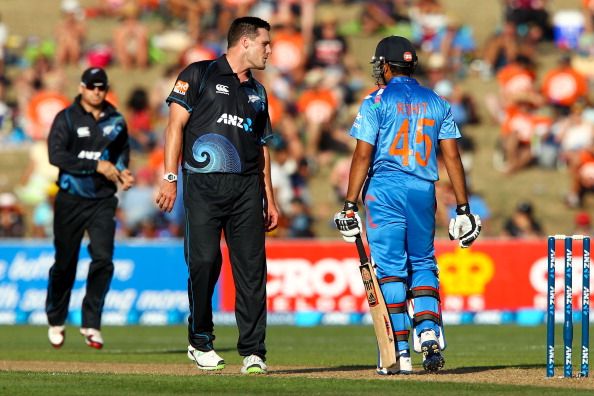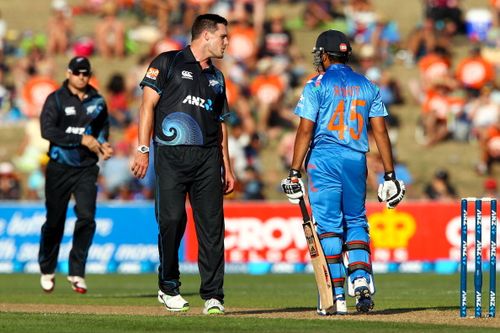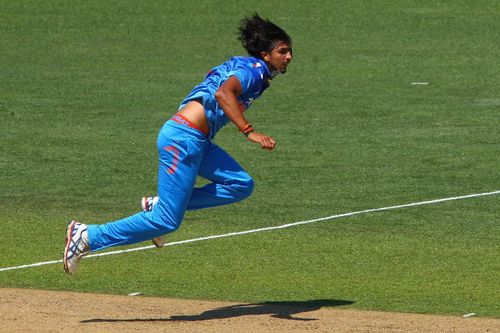
New Zealand vs India 2014: The problem of openers and death bowling for India

Rohit Sharma has not been good nick from South Africa series.
Yet another defeat for India! A match that could have been won, India lost the match by a tiny margin. After the loss in the second one-day, India surrendered the No.1 ranking to Australia, who bagged the Commonwealth Bank series against England comfortably.
With the top order not performing and a poor bowling display in death overs, India has a mountain to climb in the ongoing one-day series in New Zealand.
In both the matches, the start was not ideal. Chasing 293 in the first one-day, India managed only 15 runs in first five overs. Rohit Sharma managed to score only three runs off 23 balls. He just kept leaving the ball outside off-stump and failed to punish even the loose deliveries. Being a good backfoot player alone is not enough, but should also know to apply that.
On the other hand, Shikhar Dhawan didn’t bother to attack the new-ball bowlers. In 2013, Rohit Sharma used to give Dhawan company and Dhawan used to attack the new-ball bowlers. But here it was a different scenario. Both the batsmen were trying to survive the first ten overs as they would have thought of attacking the bowlers after the mandatory Power Play.
Perhaps they would have feared that they might get caught in slips, or by the fielders who were in catching positions. But they failed to understand that it was not typical New Zealand pitch first one-day.
Even in the second one-day, India managed only 37 runs in first ten overs, chasing an improbable target of 297 in 42 overs. When you’re chasing such a big score, the openers should have scored at a run-rate off more than 6.00 runs per over. Instead they were concentrating on surviving the new-ball and thought of switching on the gears after 15 overs.
They must understand that the surface in New Zealand will generate pace and bounce and therefore, you can’t accelerate the innings in the middle unless you have a solid start. However both were dismissed in quick succession to burden the middle order to get the runs. Nevertheless the middle order did well to get closer to the target. Had the openers scored 70 runs in first ten overs, India would have fancied the chances.
In addition to the openers, India’s poor death bowling cost them the match. With only four fielders allowed outside the circle, the new-ball bowlers did really well to remove both the openers inside ten overs at Napier. However Dhoni’s lack of options in the middle overs helped New Zealand to build an innings and subsequently in the batting Power Play, they scored 40 runs, including a 19-run over off Ishant Sharma.
What made Dhoni to give the ball to Ishant in Power Play who has been out of sorts? That’s the period where the batsmen go after the bowlers. Ishant was completely running out of ideas and he did not know what kind of lengths to bowl.
Looking at these performances, MS Dhoni has to find a way to get back into the one-day series. After an emphatic 2013, India have lost the second consecutive one-day series in overseas. The problem for India is they don’t have an effective all-rounder like James Faulkner.
Ravindra Jadeja is there but he has not been able to change the course of the match in an over. The all-rounder should’ve the ability to bat with the tail and should offer resistance to quality fast bowling. Well, in the current side, nobody has the ability to turn the game in an over and could not play short-pitched deliveries well.
India has to win the next match to keep the series alive. For that, it wouldn’t be bad idea to bring Stuart Binny into the side at the expense of Suresh Raina. If he comes into the side, it won’t be a bad idea to have him at No.7. That’s the place India are lacking in batting order and he has the ability to change the course of the match in an over.

Ishant could be effective on Auckland like in Johannesburg Test
However it’s going to be tough for India at Auckland. In the last three one-day matches at Auckland, team batting second has had the advantage. Also all three of them have been low-scoring games. With India having two good pacers, it will be a tough ask for New Zealand openers.
Also Ishant might be effective in Auckland as the surface can generate seam movement with bounce. He must concentrate on landing the ball in good length area round off-stump and then look for the seam movement with bounce. If India bats first, they must ensure that they score around 200 runs. The new-ball may seam under lights more when compared to day. So it wouldn’t be a bad idea to bat first.
Dhoni can still persist with the same squad to see whether they can exploit the condition in Auckland. If they can’t there are several places to look at. However Auckland is a place where the Indian openers would be tested. They haven’t performed on flat surface. Will they be able to get India off to a solid start in Auckland?
The openers should read the conditions and bowlers in first couple of overs. Scoring at a slow-rate in first couple of overs is not a bad idea. But they will have to accelerate from the third over and take India into a position of strength. If they can’t read the situation and bowlers, they are having some serious problems in technique.
Nevertheless India can still come back into the series, but it all depends on how the teams farewell in first ten overs.